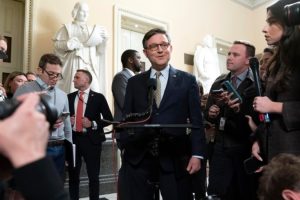() – Former President Donald Trump’s return to power is unleashing a flurry of speculation and cross-party disputes over potential Supreme Court retirements, underscoring how even a single departure by one of the nine justices can shape the law for generations.
Conservatives are preparing for Justices Clarence Thomas or Samuel Alito — both in their 70s — to resign in the next two years, whether they are prepared to do so or not.
On the left, meanwhile, Trump’s election has revived hopes among some for a sudden retirement of Justice Sonia Sotomayor, the court’s most senior liberal, and for President Joe Biden to name and confirm a replacement by the end of this year. December.
Even if any of those retirements occur in the coming weeks or months —a big “if” given that justices have often waited until age 80 to resign—neither would change the current 6-3 conservative majority balance of power on the court. However, if Trump nominates one or two younger, more like-minded conservative justices for life, he will cement the court’s rightward shift for decades.
“Alito is happily packing his bags,” predicted this week on social media Mike Davis, a conservative jurist who could play a key role in helping Trump pick his judges.
Attention to possible vacancies on the Supreme Court has so far been driven entirely by forces outside the court, and rampant speculation based on a series of murky clues and past practices. That has even inspired a debate within Republican legal circles that spilled into the public on Friday about whether such speculation is appropriate.
There is also the real possibility that it could backfire.
Progressive groups put a lot of pressure on Justice Stephen Breyer to resign during Biden’s first year in the White House, with a truck carrying billboards urging him, in capital letters, to “RETIRE” in Washington. The candidate nominated by Bill Clinton ignored the truck—and the requests—and stayed for another year, finally announcing his departure in 2022.
“No one but Justices Thomas and Alito knows when or if they will retire, and to talk about them as meat that has reached its sell-by date is reckless, uninformed and, frankly, just plain rude,” the Justice Department said Friday in a rare public statement. conservative judicial activist Leonard Leo, who was instrumental in helping Trump fill judicial vacancies in his first term.
Washington attorney Charles Cooper, an old friend of Alito who also has known Thomas for decades, mocked some of the speculation on social media.
“It is unbecoming of members of the conservative legal movement to mount any kind of campaign to pressure these two historically great judges to retire,” Cooper said. “Questions about his physical or mental health could not even be raised.”
Ed Whelan, former Supreme Court clerk and legal commentatorsaid he agreed with Leo’s opinion.
“It’s one thing to guess what a judge will decide to do,” Whelan told . “It’s quite another to try to tell a judge what to do.”
Whelan’s expectation, as he wrote in National Review this week, is for Alito to retire this spring and Thomas in 2026.
However, Davis, who is president of the conservative Article III Project, rejected Leo’s criticism.
“It’s funny how Washington conservatives now pretend to care about Supreme Court justices, after sitting on the sidelines with all the money during years of vicious attacks on conservative justices,” Davis said.
Behind much of the anxiety, on both the left and the right, is the late Justice Ruth Bader Ginsburg. When the liberal icon died in September 2020 at age 87, Trump appointed then-Judge Amy Coney Barrett, more than 35 years her junior, to replace her. As a result, several historical precedents have been overturned in the last four years, most notably Roe v. Wade in 2022.
Age and health were more important factors for Ginsburg than for Thomas, Alito or Sotomayor. Ginsburg was diagnosed with pancreatic cancer in 2009, during then-President Barack Obama’s first year in office. Although Sotomayor has made it public that she suffers from type 1 diabetes, she has shown no signs of slowing down. The same can be said of Thomas, increasingly famous on the right, especially since six years ago he became the longest-serving judge on the court.
Thomas was hospitalized for almost a week in 2022 for what a court spokesperson described as an infection.
Talks about Sotomayor resigning so Biden could name a successor and ensure the seat remains a reliable vote for the liberal wing have been brewing for months and have gone nowhere.
The process of transferring a nominee to the Supreme Court takes considerable time, often several months. Even assuming no setbacks, there is unlikely to be enough time for Biden to secure confirmation before the GOP takes control of the Senate in early January.
Thomas, 76, is the oldest of the nine current justices, followed by Alito, 74, and Sotomayor, 70. Supreme Court Chief Justice John Roberts, nominated by George W. Bush, will turn 70 on next year. Breyer was 83 when he resigned. Justice Anthony Kennedy, nominated by Ronald Reagan, had just turned 82 when he left the bench in 2018.
One of Trump’s most significant accomplishments during his first term was flooding the federal judiciary with nominees, not only the three justices he placed on the Supreme Court, but also more than 200 judges he appointed to federal district courts and appeals courts. In his only term, Trump was able to change three circuits from Democratic majority to Republican majority.
Biden has only managed to change one of those circuits.
The flurry of appointments during his first term will give Trump a wide range of potential candidates to choose from for the Supreme Court if a vacancy occurs. Judge Andrew Oldham, whom Trump appointed in 2018 to the New Orleans-based 5th U.S. Circuit Court of Appeals and who previously clerked for Alito, is often mentioned as a possible candidate. So is Judge Neomi Rao, a former Thomas staffer who Trump put on the Washington Circuit in 2019. Judge James Ho, another former Thomas staffer who Trump put on the 5th Circuit in 2018, is another.
All three are between 40 and 50 years old.
A secret recording by Martha-Ann Alito revealed earlier this year fueled speculation that the judge was fed up with Washington — and considering retirement — after revelations that several controversial flags flew at his homes in Virginia and New Jersey. However, Martha-Ann Alito’s statements were vague and Alito himself has given no public indication that he is preparing his resignation.
For one thing, justices almost always retire when a president from the same party that appointed them takes power, in part because it increases the chances that their replacement will bring a similar judicial philosophy to the court. That usually happens in the spring, just before the end of the Supreme Court session. And next year, Republicans will also control the Senate with a firm majority, facilitating Trump’s ability to confirm nominees.
However, the Supreme Court is also an institution that rewards seniority, including in opinion-making. As a senior liberal justice, Sotomayor is often in a position to assign herself the lead dissent in the court’s highest-profile cases. As a senior associate justice, Thomas has recently had the opportunity to ask the first question at oral arguments and is the first to speak after Roberts when the justices meet privately to discuss the cases.
Friends of Thomas, Alito and Sotomayor they told earlier this year that, while judges have occasionally reflected on retirements, the tone reflected casual thoughts rather than concrete plans.
The Supreme Court did not respond to a request for comment.
“Given the importance of the Supreme Court, I don’t think this is avoidable,” said Josh Blackman, a professor at South Texas College of Law in Houston, who has also publicly speculated about judicial vacancies in a popular conservative legal blog. “To be fair, it is rude to talk about a judge making the decision to resign. It’s also pretty common when a new administration comes to town to talk about these things.”
Senior Supreme Court Analyst Joan Biskupic contributed to this report.















Add Comment